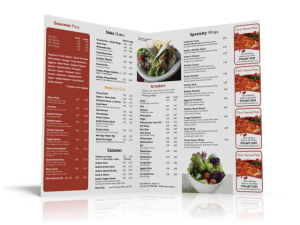Pricing Your Restaurant Menu: How to Make More, Spend Less
Is your menu REALLY generating a profit?
Building a menu can be fun, rewarding, and if you are like most restaurant operators — absolutely terrifying! 
Why?
Because if your menu does not look great, perform well, and reflect the optimum price points for each dish (from both a consumer and profitability) perspective, your restaurant may struggle to succeed.
With more than 5,000 restaurant clients nationwide, and years worth of restaurant marketing experience, our marketing team has outlined several best practices that will help you create, maintain, and market a profitable menu. More importantly, you can do so with relatively little effort, and these processes will make you more profitable with every sale.
Know Your Costs, Know Your Recipes — Be Consistent.
- Document and standardize the recipes for every item in your restaurant.
- Develop a recipe manual and determine your actual food cost for each item featured on your menu.
- Conduct "actual yield" tests. As you know, many raw products will lose weight and/or volume between the time of purchase to the time they are prepped, cooked, and on the plate. Where possible, consider using ready-to-use products that make cost estimation more accurate and eliminate waste.
Remember, every item on your menu has a labor cost associated with it. Items with higher labor requirements should increase the price of the item on your menu.
Factoid: Although food cost is an important component of menu price, no single pricing strategy can be used to arrive at the optimum price. You need to consider the variables at play such as competition, popularity, order volume, etc. to determine the price point which best suits your business revenue goals.
Pennies&ellipsis; they add up BIG time!
From working with hundreds of restaurant owners, I can recommend with great confidence, that you price your menu items so that they end in nines.
Hear me out on this&ellipsis;
By simply switching the price point from fives to nines, a restaurant that sells 2,500 items per week will add $5,200 in revenue each year with no added expense.
Basic Price Rounding Strategy
- Items less than $5 should feature increments of ($.29, $.59, $.79, $.99)
- Items more than $5 should feature increments of ($.49, $.99)
Incremental price increases move items to the next highest price point, ie., $7.49 to $7.99. At the psychological level, the customer is unlikely to notice the increased price when managed in this incremental format. A more noticeable change (and bad example) would be listing prices at $7.50 and $8.25. This type of price increase can function as a red flag for most savvy customers.
With food and labor costs considered, evaluate your prices on similar items with the competition (similar restaurants) in your local market. If you are below the market, there might be an opportunity for price increases, if you are above the market, you may need to incrementally reduce prices — and then generate awareness through direct mail and web-based marketing campaigns. When it comes to pricing and price changes — keep your customers engaged.
Expert Recommendation: When increasing item prices due to increased costs, or budget requirements, it is a good idea to also lower some prices. By doing so, you can tell customers that you have lowered prices on many items too. Turn a perceived negative (price increase) into a positive (we lowered some prices too) with this easy tip.
The "Money Makers"
Beverages
- Most national chains charge approximately $2 each for soft drinks, teas, and name-brand beverages.
- You can charge higher prices for "signature drinks" whether they include alcohol or are non-alcoholic.
Upsells & Add-Ons
- Offer toppings and add-ons to current menu items to increase ticket sizes
Salads: grilled chicken, blackened shrimp, steak
Steaks: sautéed mushrooms, crumbled bleu cheese, cheese, shrimp
Burgers/Chicken- fried onions, curly fries, bacon, veggies, etc
Signature Dishes
Do you have any signature dishes, specialty items, or "famous" dishes?
- Signature dishes prevent customers from "price shopping" as there are no comparable restaurants to evaluate. Use signature dishes to set your restaurant (and profitability) apart from competitors.
Factoid: Most restaurant owners constantly worry about their menu pricing and update their rates far too often as a result. Use "hard" facts and base pricing off of your actual costs to find peace and profitability with your pricing.
These fundamentals of profitable menu pricing should be applied wherever possible. As your food costs and labor costs increase/decrease you may need to periodically adjust your pricing.
For more helpful tips, strategies, and marketing articles browse the blog.

